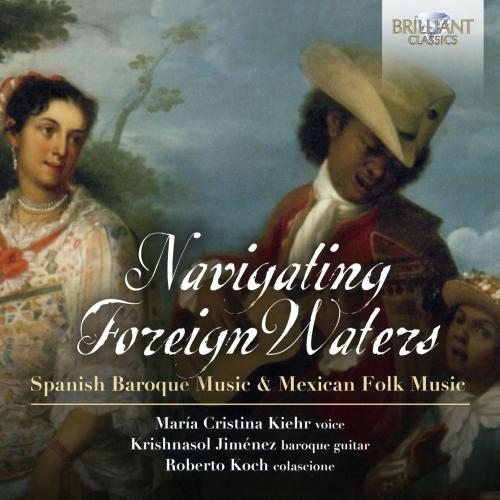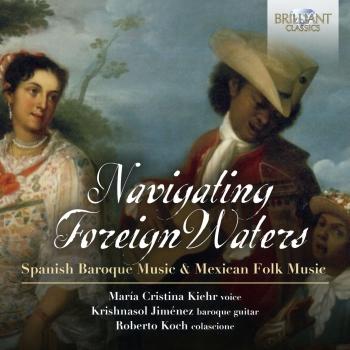
Navigating Foreign Waters: Spanish Baroque Music & Mexican Folk Music Maria Cristina Kiehr, Krishnasol Jiménez, Roberto Koch
Album Info
Album Veröffentlichung:
2021
HRA-Veröffentlichung:
28.05.2021
Label: Brilliant Classics
Genre: Classical
Subgenre: Vocal
Interpret: Maria Cristina Kiehr, Krishnasol Jiménez, Roberto Koch
Komponist: Santiago de Murcia (1673–1739), Gaspar Sanz (1640–1710)
Das Album enthält Albumcover
- Gaspar Sanz (1640 - 1710):
- 1 Sanz: La bruja - Jácaras por la e 06:24
- Santiago de Murcia (1673 - 1739):
- 2 Murcia: La carretera - Cumbees 06:36
- 3 Murcia: Los juiles - Jácaras por la e 03:50
- 4 Murcia: Siquisiri - Jácaras de la Costa 04:04
- 5 Murcia: Los Chiles verdes - Tarantelas por la e 06:16
- 6 Murcia: La lloroncita - los Ympossibles 04:34
- 7 Murcia: María Chuchena - la Jotta 05:06
- 8 Murcia: El gallo - Folías Gallegas 05:07
- 9 Murcia: Fandanguito - Fandango 04:24
- 10 Murcia: Aguanieve - Zarambeques o Muecas 05:01
Info zu Navigating Foreign Waters: Spanish Baroque Music & Mexican Folk Music
In this expert recording, singer Roberto Balconi and group Fantasyas approach Giulio Caccini’s (1551-1618) Le Nuove Musiche with a focus on authentic performance practice as specified in great detail by the composer himself in the preface to the work. Dated 1601 and published in 1602, Le Nuove Musiche contains madrigals and arias for solo voice with basso continuo accompaniment and is a seminal collection in the establishment of the new Baroque style of monody which broke with Renaissance practices in many significant ways. In the preface, Caccini exhorts the performers to honour the primacy of speech and speech rhythm. Balconi explains: ‘Monody is more about words and metre than singing, focusing on the declamation of the semantic, rhetorical and prosodic elements of the poetic text rather than constructing a melody.’ This was a departure from the combined voices of Renaissance counterpoint, a move towards solo poetic recitation with the nuance of music in service of the meaning. Caccini lays out guidelines for the retrained and appropriate use of the improvised ornamentation that was the vogue in his day but which he considered too often gratuitous and overly virtuosic at the expense of the music. He stresses these should be used judiciously so that the singer can ‘almost speak in harmony’, in other words recite the text more or less normally using music. In adhering assiduously to Caccini’s compositional concept, Balconi and Fantazyas create an authentic and powerfully moving document of the birth of monody, which not only inspired the invention of opera but changed the entire course of music history.
María Cristina Kiehr, voice
Krishnasol Jiménez, baroque guitar
Roberto Koch, colascione
María Cristina Kiehr
ist in Argentinien geboren und erhielt dort auch ihre erste musikalische Ausbildung. 1983 kam sie nach Europa und studierte bei René Jacobs an der Schola Cantorum Basiliensis, um sich besonders im Barockgesang weiterzubilden, während sie gleichzeitig Gesangstechnik bei Eva Krasznai studierte. Sie ist heute eine der unumstrittenen Größen des Barockgesangs und hat weltweit bei zahlreichen Konzerten und Aufnahmen mitgewirkt, mit dem Concerto Vocale (René Jacobs), Concerto Köln, dem Ensemble 415 (Chiara Banchini), Cantus Cölln (Konrad Junghänel), dem Ensemble Vocal Européen (Philippe Herreweghe), Hespèrion XX (Jordi Savall), La Fenice (Jean Tubéry), Elyma, dem Nederlands Kamerkoor, und sie hat mit Frans Brüggen, Gustav Leonhardt und Nikolaus Harnoncourt zusammengearbeitet.
Das besondere Interesse von María Cristina Kiehr gilt der Musik des Frühbarock. Sie ist Mitgründerin des Ensembles La Colombina.
1988 hatte sie ihr Operndebüt in Innsbruck mit Cavallis Giasone unter der Leitung von René Jacobs. Ebenfalls unter René Jacobs wirkte sie mit bei Produktionen der Opern L'incoronazione di Poppea von Monteverdi, Orontea von Cesti und Dido and Aeneas, unter Gabriel Garrido sang sie die Venere in La Dafne von Gagliano, Musica und Speranza in L'Orfeo und die Minerva in Il ritorno d'Ulisse in patria von Monteverdi.
Ihre Begegnung mit dem Cembalisten und Organisten Jean-Marc Aymes führte zur Gründung des Ensembles Concerto Soave, das sich besonders der italienischen Musik des frühen 17. Jahrhunderts widmet. Es bildet ein Concerto im ursprünglichen Sinne, d.h. eine reiche Instrumentalpalette (Cembalo, Orgel, Erzlaute, Viola da gamba, Harfe, …), die den Sologesang begleitet. Es ist bei allen namhaften Festivals der Alten Musik aufgetreten: Utrecht, Ambronay, Sablé-sur-Sarthe, Montreux, Pontoise, Simiane-la-Rotonde, Semaine Sainte en Arles, sowie in Marseille, Lausanne und Paris (Cité de la Musique).
Dieses Album enthält kein Booklet










